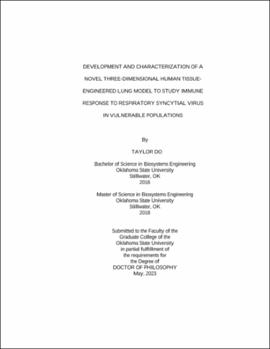| dc.contributor.advisor | Fahlenkamp, Heather | |
| dc.contributor.author | Do, Taylor | |
| dc.date.accessioned | 2023-08-30T19:45:01Z | |
| dc.date.available | 2023-08-30T19:45:01Z | |
| dc.date.issued | 2023-05 | |
| dc.identifier.uri | https://hdl.handle.net/11244/339002 | |
| dc.description.abstract | Lower respiratory illnesses are one of the leading causes of mortality in the United States. Viral lung infections, such as respiratory syncytial virus (RSV), often lead to chronic complications in immunocompromised populations. One of the first steps in reducing or eliminating complications caused by lower respiratory infections is accurately modeling the response of human tissue and cells. This work focused on developing and characterizing a three-dimensional human tissue-engineered lung model (3D-HTLM) using primary human cells to examine the immune response of vulnerable populations to RSV. To achieve this, a collagen hydrogel scaffold was constructed on a PET membrane in a hanging cell culture insert. Human small airway epithelial cells (SAECs), human pulmonary endothelial cells (HPMECs), human pulmonary fibroblasts (HPFs) and myeloid cells were then seeded on the scaffold to create a complete model. Each cell type was characterized within the model using flow cytometry, immunofluorescence, hematoxylin and eosin (H&E) stain, and trans-epithelial electrical resistance (TEER). Myeloid cells successfully migrated into the collagen hydrogel matrix, mimicking in vivo conditions. Models were digested to harvest and characterize cells. Myeloid cells recovered from the models upregulated tissue resident markers, CD169, CD206, and CD163, indicating differentiation into lung macrophages. Models were then challenged with TLR-4 agonist lipopolysaccharide (LPS) to validate the immunocompetency of the 3D-HTLM. Cells within the model demonstrated a response to LPS challenge by upregulating ICAM and interleukin (IL)-10, as well as donor-dependent tumor necrosis factor (TNF)-α. The 3D-HTLM was infected with varying multiplicities of infection (MOI) of RSV to determine an appropriate concentration to illicit an immune response. Models with adult myeloid cells demonstrated an immune response to RSV with MOI 10 by significantly upregulating IL-10 and CCL2. Myeloid cells from elderly (65+) and neonatal donor samples were utilized in the 3D-HTLM to determine expression levels of costimulatory markers in response to RSV infection. There was no significant change in costimulatory marker levels between populations upon RSV infection. Future studies can focus on other aspects of immune response to RSV in vulnerable populations within the established 3D-HTLM, such as cytokine expression. | |
| dc.format | application/pdf | |
| dc.language | en_US | |
| dc.rights | Copyright is held by the author who has granted the Oklahoma State University Library the non-exclusive right to share this material in its institutional repository. Contact Digital Library Services at lib-dls@okstate.edu or 405-744-9161 for the permission policy on the use, reproduction or distribution of this material. | |
| dc.title | Development and characterization of a novel three-dimensional human tissue-engineered lung model to study immune response to respiratory syncytial virus in vulnerable populations | |
| dc.contributor.committeeMember | Ramsey, Josh | |
| dc.contributor.committeeMember | Feng, Yu | |
| dc.contributor.committeeMember | Oomens, Tom | |
| osu.filename | Do_okstate_0664D_18173.pdf | |
| osu.accesstype | Open Access | |
| dc.type.genre | Dissertation | |
| dc.type.material | Text | |
| dc.subject.keywords | co-culture | |
| dc.subject.keywords | immune response | |
| dc.subject.keywords | lung model | |
| dc.subject.keywords | primary cells | |
| dc.subject.keywords | respiratory syncytial virus | |
| dc.subject.keywords | tissue engineering | |
| dc.subject.keywords | RSV | |
| thesis.degree.discipline | Chemical Engineering | |
| thesis.degree.grantor | Oklahoma State University | |
